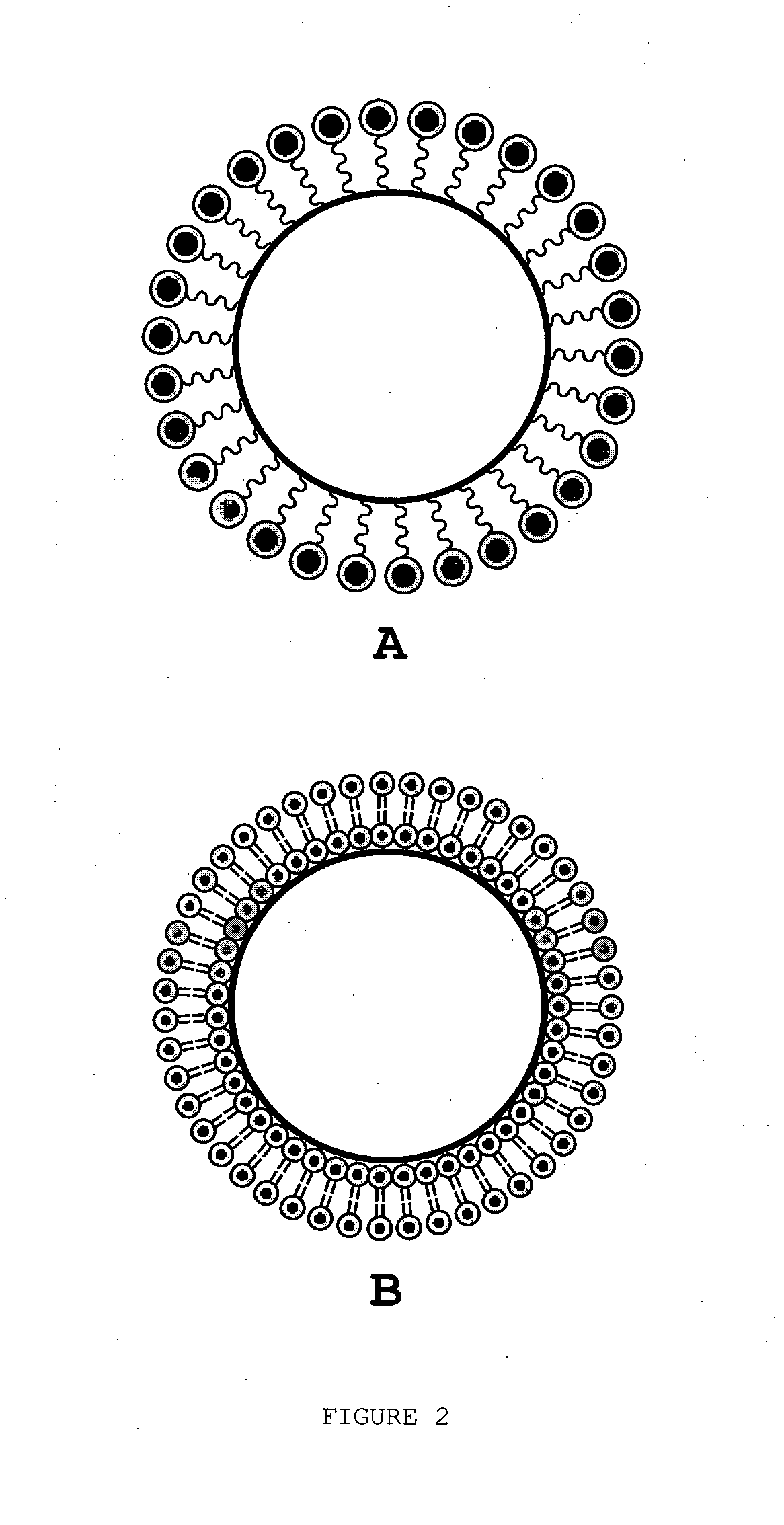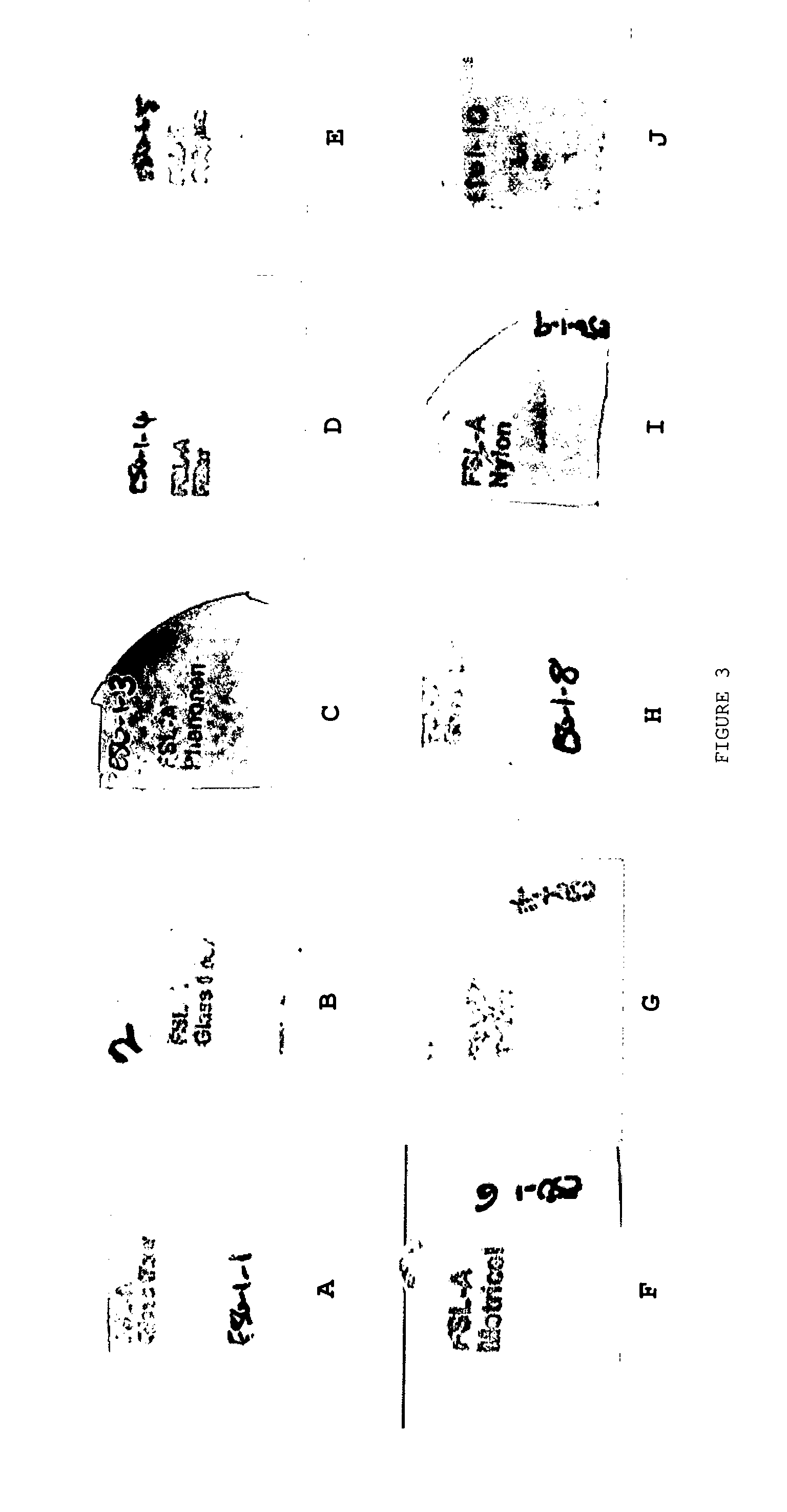Biocompatible method of functionalising substrates with inert surfaces
- Summary
- Abstract
- Description
- Claims
- Application Information
AI Technical Summary
Benefits of technology
Problems solved by technology
Method used
Image
Examples
example 1
[0054]Dispersions of the aminopropyl derivative of blood group A trisaccharide (Atri-S1) and the construct Atri-sp-Ad-DOPE (FSL-A) were prepared at a concentration of 0.2 mM in PBS containing 0.01% polyoxyethylene (20) sorbitan monolaureate (TWEEN™ 20) and 1% inkjet ink (magenta).
[0055]Atri-S1 (as described in the specification accompanying international application no. PCT / NZ2005 / 000052 (publ. no. WO 2005 / 090368))
[0056]FSL-A (as described in the specification accompanying international application no. PCT / NZ2005 / 000052 (publ. no. WO 2005 / 090368))
[0057]The dispersions were loaded into separate ink cartridges of an EPSON STYLUS™ T21 piezoelectric inkjet printer. The identity of the dispersion and substrate were printed onto samples of the following substrates: glass fibre filter paper GC-50 (Advanetc); glass microfiber filter GF / B (Whatman); nylon membrane filter 0.2 μm (Phenomenex); filter paper 1 (Whatman); polypropylene filter membrane (Gelman Sciences); METRICEL™ filter membrane ...
example 2
[0058]Dispersions of the construct Btri-sp-Ad-DOPE (FSL-B) and its monoacyl counterpart (monoacyl-B) were prepared at a concentration of 0.4 mM in PBS containing 0.01% polyoxyethylene (20) sorbitan monolaureate (TWEEN™ 20) and 1% inkjet ink (magenta).
[0059]FSL-B (as described in the specification accompanying international application no. PCT / NZ2005 / 000052 (publ. no. WO 2005 / 090368))
[0060]Monoacyl-B (as described in the specification accompanying international application no. PCT / NZ2005 / 000052 (publ. no. WO 2005 / 090368))
[0061]The dispersions were loaded into separate ink cartridges of an EPSON STYLUS™ T21 piezoelectric inkjet printer. The identity of the dispersion and substrate were printed onto samples of the following substrates: glass fibre filter paper GC-50 (Advanetc); glass microfiber filter GF / B (Whatman); nylon membrane filter 0.2 μm (Phenomenex); filter paper 1 (Whatman); polypropylene filter membrane (Gelman Sciences); METRICEL™ filter membrane GA-3 1.2 μm (Gelman Science...
example 3
[0062]Dispersions of the constructs FSL-A and FSL-Biotin at a concentration of 0.5 mg / ml (circa 6 mM) in PBS were painted onto glass fibre threads using a brush. The painted thread was allowed to dry between applications of subsequent layers.
[0063]FSL-Biotin (as described in the specification accompanying international application no. PCT / NZ2008 / 000266 (publ. no. WO 2009 / 048343))
[0064]A glass fibre thread painted with 1 to 3 layers of the dispersion of FSL-A was immersed in a solution of 2% (w / v) bovine serum albumin (BSA) in PBS for 1 hour prior to being rinsed and immersed in a 1 in 5 dilution in BSA of anti-B immunoglobulin (EPICLONE™ monoclonal, CSL Limited) for 30 minutes. The painted glass fibre thread was then washed 6 times with PBS prior to being immersed in a 1:400 dilution of alkaline phosphatase conjugated sheep anti-mouse immunoglobulin (Chemicon) for 30 minutes. The thread was then washed 6 times with PBS followed by a washing of substrate buffer (100 mM Tris, 100 mM N...
PUM
| Property | Measurement | Unit |
|---|---|---|
| Dispersibility | aaaaa | aaaaa |
Abstract
Description
Claims
Application Information
 Login to view more
Login to view more - R&D Engineer
- R&D Manager
- IP Professional
- Industry Leading Data Capabilities
- Powerful AI technology
- Patent DNA Extraction
Browse by: Latest US Patents, China's latest patents, Technical Efficacy Thesaurus, Application Domain, Technology Topic.
© 2024 PatSnap. All rights reserved.Legal|Privacy policy|Modern Slavery Act Transparency Statement|Sitemap



